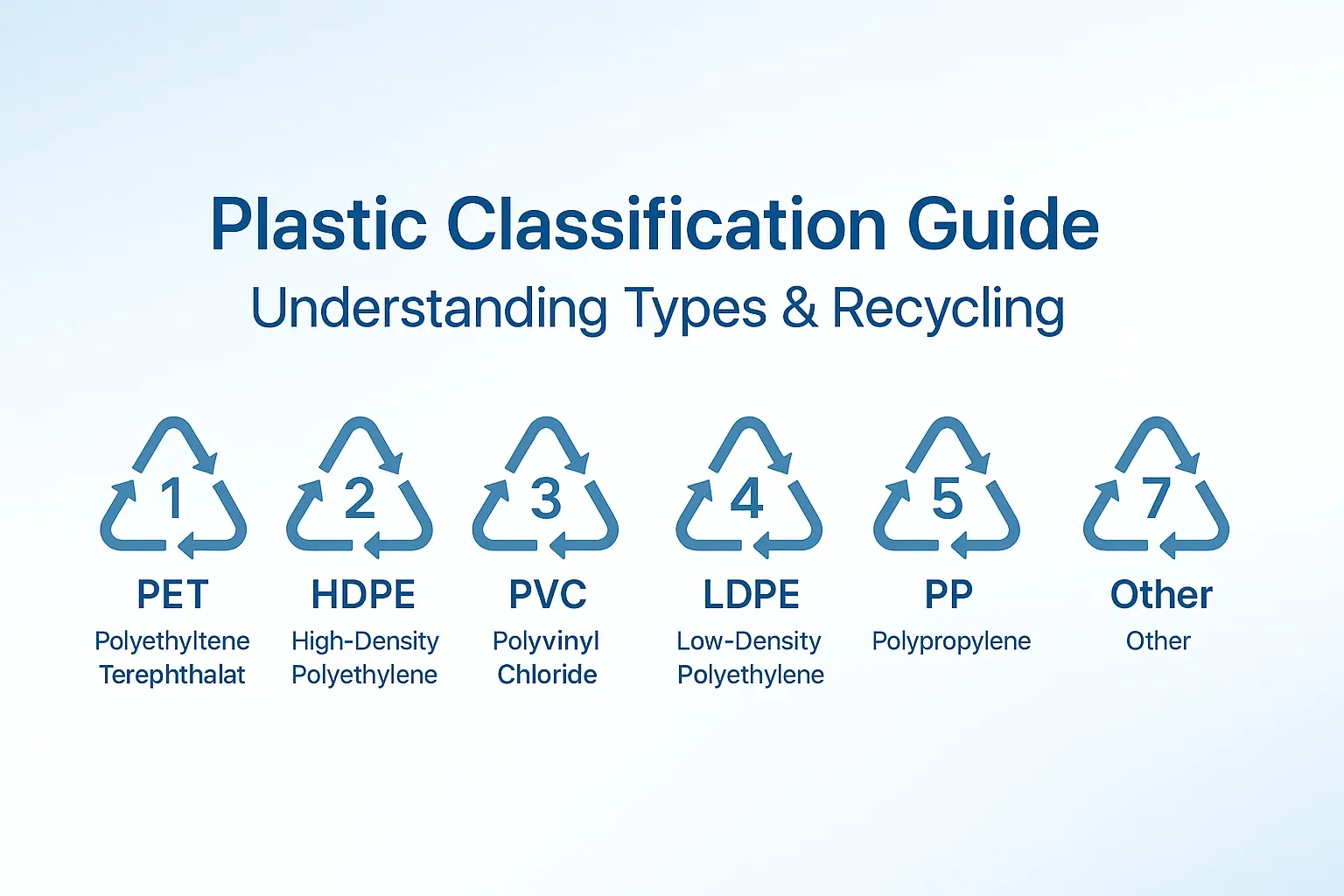Plastic. It’s a material that has truly shaped our modern world. From the packaging that keeps our food fresh and safe to the intricate components powering our smartphones and life-saving medical devices, plastic is undeniably woven into the fabric of our daily lives. But this convenience often comes with an environmental cost, sometimes called “white pollution” – the widespread issue of plastic waste accumulating in our ecosystems. This Comprehensive Plastic Classification Guide is designed to help you navigate the complex world of plastics. We’ll explore the different types, their common uses, their properties, and, crucially, their impact on our planet. By understanding these distinctions, we can all make more informed choices, improve our recycling habits, and contribute to a healthier environment.
Why Understanding Plastic Types Matters
You’ve probably seen those little numbers in triangles on the bottom of plastic containers. Ever wondered what they mean? These are Resin Identification Codes (RICs), and they tell us about the type of plastic resin used to make the product. Knowing these codes isn’t just for industry experts; it’s crucial for consumers, manufacturers, and environmental advocates. This knowledge helps us:
- Recycle Effectively: Different plastics have different chemical compositions and cannot always be recycled together. Sorting plastics correctly prevents contamination in the recycling stream, leading to higher quality recycled materials.
- Make Safer Choices: Some plastics are better suited for food and drink storage than others. Understanding potential health risks associated with certain plastics can guide your purchasing decisions.
- Reduce Environmental Impact: By choosing plastics that are more readily recyclable or opting for alternatives, we can lessen the burden of plastic waste on our planet.
- Support a Circular Economy: Proper classification and recycling are key to closing the loop on plastic use, turning waste into valuable resources.
Your In-Depth Guide to Common Plastic Classifications
Plastics are a diverse family of synthetic or semi-synthetic materials that use polymers as a main ingredient. Their versatility means they can be molded, extruded, or pressed into solid objects of various shapes. Let’s dive into the most common types you’ll encounter, often identified by their Resin Identification Code (RIC).
#1 Полиетилен терефталат (ПЕТ или ПЕТЕ)
Уобичајена употреба: This is one of the most common plastics you’ll find. Think clear beverage bottles (water, soda), food containers (like peanut butter jars or salad dressing bottles), and even some textile fibers (polyester clothing).
Својства: PET is lightweight, strong, and typically transparent. It provides a good barrier to gas and moisture, which helps keep food and drinks fresh.
Recyclability & Safety: PET is widely recycled! It can be turned into new bottles, containers, carpet fibers, or fabric for clothing. While generally considered safe for single food and drink use, it’s often recommended to avoid reusing PET containers for food/drink, especially if they show signs of wear or have been exposed to heat, due to the potential for chemical leaching and bacterial growth.

#2 Полиетилен високе густине (HDPE)
Уобичајена употреба: HDPE is another very common and versatile plastic. You’ll find it in milk jugs, detergent and shampoo bottles, grocery bags, cereal box liners, and even some plastic lumber, pipes, and toys.
Својства: It’s known for its excellent strength-to-density ratio, making it sturdy and resistant to moisture and chemicals. It can be translucent or opaque.
Recyclability & Safety: HDPE is widely recycled and considered one of the safer plastics for food and drink. Recycled HDPE is used to make new bottles, pipes, plastic lumber, and more.

#3 Polyvinyl Chloride (PVC or V)
Уобичајена употреба: PVC is a durable and versatile plastic used in things like plumbing pipes, window frames, vinyl flooring, electrical cable insulation, some clear food packaging (like cling film, though less common now), and inflatable products.
Својства: It can be rigid or flexible, depending on the additives used. It’s known for its durability and resistance to chemicals and weathering.
Recyclability & Safety: PVC is rarely recycled through curbside programs. Its production and disposal can release harmful chemicals, including dioxins and phthalates (plasticizers). Phthalates, in particular, have raised health concerns, and it’s generally advised to avoid using PVC for food storage or for children’s toys, unless specified as phthalate-free.

#4 Полиетилен ниске густине (LDPE)
Уобичајена употреба: LDPE is the flexible plastic often used for plastic shopping bags, bread bags, shrink wrap, squeezable bottles (like for honey or ketchup), and some food container lids.
Својства: It’s soft, flexible, lightweight, and provides a good moisture barrier.
Recyclability & Safety: LDPE is not always accepted in curbside recycling programs, but many grocery stores offer collection points for clean and dry plastic bags and films. It’s considered a relatively safe plastic for food contact. When recycling, ensure items are clean and dry, and check local guidelines or store drop-off programs.

#5 Полипропилен (ПП)
Уобичајена употреба: PP is a sturdy plastic with good heat resistance. You’ll find it in yogurt containers, margarine tubs, medicine bottles, bottle caps, straws, and some automotive parts and reusable food containers.
Својства: It’s strong, flexible, and has a high melting point, making it suitable for items that need to withstand higher temperatures (like microwavable containers, though always check labels).
Recyclability & Safety: PP is increasingly accepted in curbside recycling programs. It’s considered a safe plastic for food contact. Always check with your local recycling provider to see if they accept #5 plastics.

#6 Polystyrene (PS)
Уобичајена употреба: Polystyrene comes in two main forms: solid (used for disposable cutlery, CD cases, smoke detector housings) and foamed (commonly known by the trademark Styrofoam™), used for disposable coffee cups, food take-out containers, and packaging peanuts.
Својства: It’s lightweight and provides good insulation, but it’s also brittle.
Recyclability & Safety: PS is notoriously difficult to recycle and is not widely accepted in curbside programs. Its bulky, lightweight nature makes it expensive to transport and process. There are also concerns about styrene, a potential human carcinogen, leaching into food, especially when heated. Many communities are banning or restricting its use.

#7 Other (Miscellaneous Plastics)
Уобичајена употреба: This category is a catch-all for plastics not defined by the other six codes. It includes materials like Polycarbonate (PC), Acrylonitrile Butadiene Styrene (ABS), Polylactic Acid (PLA – a bioplastic), nylon, and acrylic. You might find these in baby bottles (though many are now BPA-free PC), reusable water bottles, electronics casings, car parts, and some food containers.
Својства: Varies widely depending on the specific resin or combination of resins.
Recyclability & Safety: These plastics are generally not recycled through municipal programs due to their varied chemical compositions and lack of specialized recycling facilities. Some, like polycarbonate, have faced scrutiny for containing Bisphenol A (BPA), an endocrine disruptor. Many manufacturers have moved to BPA-free alternatives. Bioplastics like PLA are designed to be compostable in industrial facilities but can contaminate conventional plastic recycling streams if mixed in.
Navigating the World of Plastics: Key Takeaways
Understanding the different types of plastics is more than just an academic exercise; it’s a practical skill for everyday life. By recognizing these classifications, we can:
- Decode Labels: Quickly identify the type of plastic an item is made from using the Resin Identification Code.
- Recycle Smarter: Know which plastics are accepted by your local recycling program, reducing contamination and improving recycling efficiency. Remember, the chasing arrows symbol with a number identifies the *type* of plastic, not a guarantee that it’s recyclable everywhere. Always check local guidelines!
- Prioritize Safety: Make informed choices about plastics used for food and drink, opting for safer alternatives when possible.
- Reduce “White Pollution”: By making conscious choices to reduce, reuse, and correctly recycle plastics, we can all play a part in tackling plastic waste.
This Plastic Classification Guide is your starting point. The world of plastics is constantly evolving, with new materials and recycling technologies emerging. Stay curious, keep learning, and together we can make a positive impact on our environment.
Have Questions or Need Recycling Solutions?
Understanding plastics is the first step. If you’re looking for advanced recycling machinery or have questions about tackling specific plastic waste streams, we’re here to help. To get the latest information on our solutions, prices, and lead times, send us a message using the form below.



